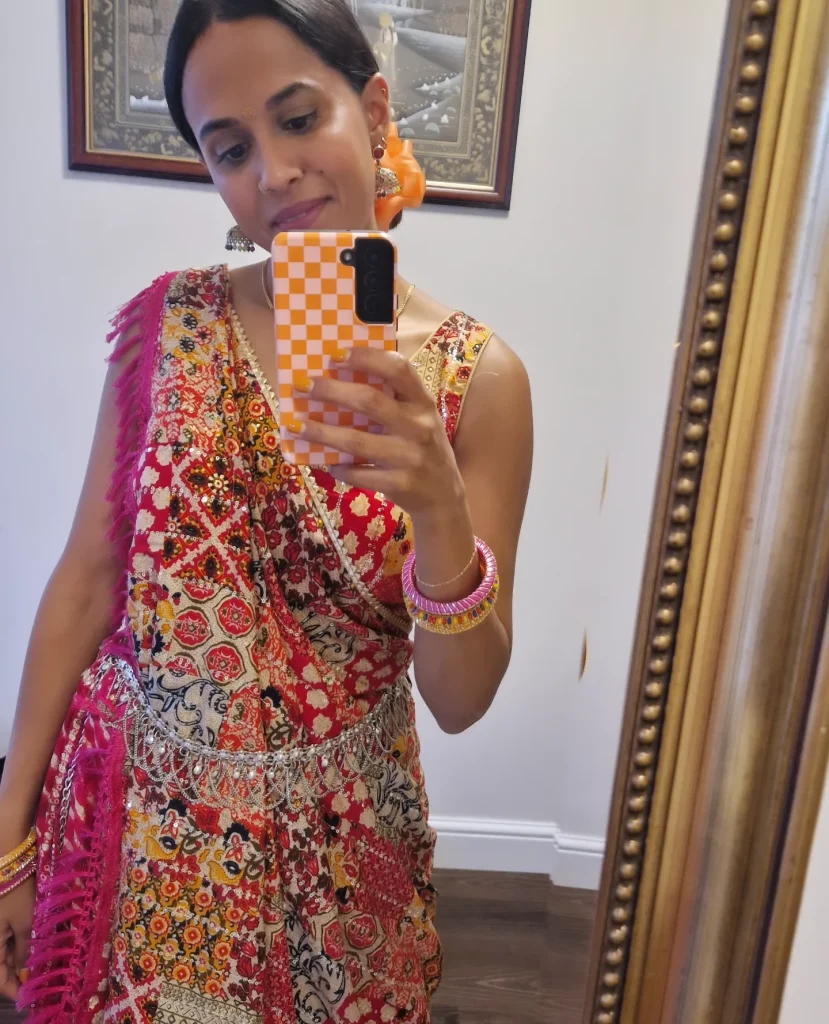We celebrated the Hindu festival of Navratri in September and I could feel a powerful energy in the air. When we were little I remember the collection of outfits my mum would dress us in, the array of beautiful jewellery we would adorn ourselves with and the noise the janjra (anklets) on our ankles would make as we made our way to the school hall for an evening of worship, dancing and celebration.
As I’ve grown and evolved and through my own reading and exploration of my religion, my culture and the parts of myself that I so often rejected, I’ve come to find so much comfort, belonging and understanding. The teachings with which I grew up, the devotion I saw through my mum, the deeper understanding of what each of the festivals mean has sparked a new flame in me.
I don’t think I ever really embodied the power of my divine feminine and for so long I never really knew what it meant to be blessed to be a woman. Society strips women of so much of their power, often making them inferior to their male counterparts. Yet through religions such as Hinduism, the feminine is often revered, idolised and worshipped. There is much to be learnt by society through these stories and scriptures.
Goddess Durga & Her Colours
Navratri is the celebration of good over evil and the divine feminine. Across nine nights we celebrate the nine forms of Goddess Durga. Goddess Durga is often depicted with several arms yielding divine weapons that signify her power as a warrior, a protector of peace and order and the ability to overcome challenges within life.
Each night is a celebration of a different form of Goddess Durga and is signified by a specific colour which you are encouraged to wear or offer to Maa through gifts such as flowers. Through my research I found the explanations below.
Navratri Night One: Shailaputri Maa
Associated with a sense of deeper connection, spiritual awakening and life purpose. On the first night of Navratri, Shilaputri is worshipped and associated with the colour white to bring peace, harmony and balance in attainment of purpose and awakening.
Navratri Night Two: Brahmacharini Maa
A symbol of study, intellect and spiritual devotion along with a call for greater patience, perseverance and simplicity. Brahmacharini is worshipped on the second night and represented by the red. Red as you may know often signifies power and passion, representing our inner fire and resolve. The adrenaline that pulses through the body when we are in contact with the colour red allows us to preserve with passion and drive.
Navratri Night Three: Chandraghanta Maa
The recognition of inner courage and discipline. Chandraghanta is represented by royal blue, embodying trust and stability which we often see through colour theory. When I see blue it always gives a feeling of safety.
Navratri Night Four: Kushmanda Maa
Believed to be the creator of the light and energy of the sun, she is represented by yellow. Yellow brings joy and happiness as it releases serotonin into the body. On our dark days, yellow can bring in the lightness we need to calm the voice of pain.
Navratri Night Five: Skandamata Maa
Skandamata – is known for motherly love and protection and this day is represented by the colour green. Green is a deeply grounding colour, associated with nature and prosperity. Also known to help calm stress levels. The colour green is also in relation to the planet mercury which is linked to intellect, communication and learning.
Navratri Night Six: Katyayani Maa
Representing the ability to overcome evil and associated with the colour grey. Grey is a grounding colour and brings a sense of balance coming black and white. Much like we need balance in the world and in our day to day order.
Navratri Night Seven: Kalaratri Maa
The removal of darkness and bad times, Kalaratri is represented by orange, my favourite colour! Whenever I have a sad, dark or down day, orange is always the colour that gives me a boost. It bring the beautiful joy of yellow with the passion and fire of red.
Navratri Night Eight: Nahagauri Maa
Symbolising purity and peace. Peacock green is the colour of the eight day which I find beautiful as it feel vibrant, yet grounding and prosperous! It is seen to symbolise new beginnings.
Navratri Night Nine: Siddhidatri Maa
Representing spiritual power and associated with the beautiful colour of pink. Pink the symbol of love, compassion and harmony. There is such a nurturing feeling to pink as well which I feel is beautifully depicted here.
When I was younger my mum always told us there were certain colours you were encouraged to wear each night (not entirely always practical to have nine different outfits in all the colours!). But I’m so glad I’ve taken time now to learn more about their significance.
On the first night of Navratri I practiced a Goddess Shakti yoga flow with Henika. Feeling into my body, hearing more about the story of Durga Maa and how she defeated the demon Mahishasura was a really special way to begin the festival.
This year I was only able to attend one day of celebration. I wore a new chanya choli we bought from India and spent time with my family dancing the traditional folk dance of garba, ranjanyo and dhandiya.
Navratri has found a new special place in my hear as my honour my own inner divine and shakti. I hope this post gave you further understanding of the festival, its significance and how we all have an inner divine within us.

I would love for you to share your stories of Navratri with me in the comments. And you can see more pics from my celebration here or book in for a call here to talk more about the divine feminine within and how we can begin to unleash her!











